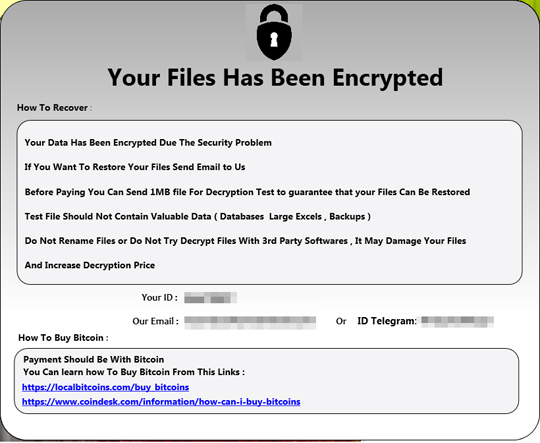Ransom.MSIL.FAKEWCRY.A
Trojan:Win32/Wacatac.B!ml(MICROSOFT); Trojan.Win32.Diztakun.bors(KASPERSKY); Trojan-Ransom.Wannacryfake(IKARUS);
Windows


Threat Type: Ransomware
Destructiveness: No
Encrypted:
In the wild: Yes
OVERVIEW
Downloaded from the Internet
This Ransomware arrives on a system as a file dropped by other malware or as a file downloaded unknowingly by users when visiting malicious sites.
It adds certain registry entries to disable the Task Manager. This action prevents users from terminating the malware process, which can usually be done via the Task Manager.
It drops files as ransom note. It avoids encrypting files with the following file extensions.
TECHNICAL DETAILS
Displays message/message boxes, Encrypts files, Connects to URLs/IPs
Arrival Details
This Ransomware arrives on a system as a file dropped by other malware or as a file downloaded unknowingly by users when visiting malicious sites.
Installation
This Ransomware drops the following copies of itself into the affected system:
- %User Startup%\Runtime Broker.exe
(Note: %User Startup% is the current user's Startup folder, which is usually C:\Windows\Profiles\{user name}\Start Menu\Programs\Startup on Windows 98 and ME, C:\WINNT\Profiles\{user name}\Start Menu\Programs\Startup on Windows NT, C:\Documents and Settings\{User name}\Start Menu\Programs\Startup on Windows 2003(32-bit), XP and 2000(32-bit), or C:\Users\{user name}\AppData\Roaming\Microsoft\Windows\Start Menu\Programs\Startup on Windows Vista, 7, 8, 8.1, 2008(64-bit), 2012(64-bit), 10(64-bit).)
It drops the following files:
- %User Startup%\Ransomware Snc.exe - ransom note GUI
- {malware file path}\Ransomware Snc.exe - ransom note GUI
- {malware file path}\icon.ico - icon of "Ransomware Snc.exe"
- {malware file path}\logs.logs - contains the decryption key and error message (if connection to URL fails)
(Note: %User Startup% is the current user's Startup folder, which is usually C:\Windows\Profiles\{user name}\Start Menu\Programs\Startup on Windows 98 and ME, C:\WINNT\Profiles\{user name}\Start Menu\Programs\Startup on Windows NT, C:\Documents and Settings\{User name}\Start Menu\Programs\Startup on Windows 2003(32-bit), XP and 2000(32-bit), or C:\Users\{user name}\AppData\Roaming\Microsoft\Windows\Start Menu\Programs\Startup on Windows Vista, 7, 8, 8.1, 2008(64-bit), 2012(64-bit), 10(64-bit).)
Other System Modifications
This Ransomware adds the following registry entries to disable the Task Manager:
HKEY_CURRENT_USER\Software\Microsoft\
Windows\CurrentVersion\Policies\
System
DisableTaskMgr = 1
(Note: The default value data of the said registry entry is 0.)
Other Details
This Ransomware connects to the following possibly malicious URL:
- http://recoverydata.{BLOCKED}sting.com/api/?hard={used disk space}&cpu={VolumeSerialID}&dkey={decryption key}&ip={public ip address}
It does the following:
- It avoids encrypting the following files:
- C:\BOOTNXT
- C:\bootmgr
- C:\boot.sdi
- C:\BOOTSECT.BAK
- %User Startup%\Runtime Broker.exe%
- %User Startup%\Ransomware Snc.exe
- {encrypted folder}\ReadMe.txt
- It encrypts all drives.
- It executes the following files after encryption:
- {malware file path}\Ransomware Snc.exe
(Note: %User Startup% is the current user's Startup folder, which is usually C:\Windows\Profiles\{user name}\Start Menu\Programs\Startup on Windows 98 and ME, C:\WINNT\Profiles\{user name}\Start Menu\Programs\Startup on Windows NT, C:\Documents and Settings\{User name}\Start Menu\Programs\Startup on Windows 2003(32-bit), XP and 2000(32-bit), or C:\Users\{user name}\AppData\Roaming\Microsoft\Windows\Start Menu\Programs\Startup on Windows Vista, 7, 8, 8.1, 2008(64-bit), 2012(64-bit), 10(64-bit).)
Ransomware Routine
This Ransomware avoids encrypting files found in the following folders:
- C:\Windows
- C:\Windows.old
- C:\Boot
- C:\Windows10Upgrade
- C:\$Windows.~WS
It appends the following extension to the file name of the encrypted files:
- .[{VolumeSerialID}][recover13@protonmail.com].Snc
It drops the following file(s) as ransom note:
- {encrypted folder}\ReadMe.txt

- %User Startup%\Ransomware Snc.exe

It avoids encrypting files with the following file extensions:
- .Snc
SOLUTION
9.850
Step 1
Trend Micro Predictive Machine Learning detects and blocks malware at the first sign of its existence, before it executes on your system. When enabled, your Trend Micro product detects this malware under the following machine learning name:
-
Troj.Win32.TRX.XXPE50FFF034
Step 2
Before doing any scans, Windows 7, Windows 8, Windows 8.1, and Windows 10 users must disable System Restore to allow full scanning of their computers.
Step 3
Note that not all files, folders, and registry keys and entries are installed on your computer during this malware's/spyware's/grayware's execution. This may be due to incomplete installation or other operating system conditions. If you do not find the same files/folders/registry information, please proceed to the next step.
Step 4
Restart in Safe Mode
Step 5
Delete this registry value
Important: Editing the Windows Registry incorrectly can lead to irreversible system malfunction. Please do this step only if you know how or you can ask assistance from your system administrator. Else, check this Microsoft article first before modifying your computer's registry.
- In HKEY_CURRENT_USER\Software\Microsoft\Windows\CurrentVersion\Policies\System
- DisableTaskMgr = "1"
- DisableTaskMgr = "1"
Step 6
Search and delete this file
- %User Startup%\Runtime Broker.exe%
- %User Startup%\Ransomware Snc.exe
- {malware file path}\Ransomware Snc.exe
- {malware file path}\icon.ico
- {malware file path}\logs.logs
Step 7
Restart in normal mode and scan your computer with your Trend Micro product for files detected as Ransom.MSIL.FAKEWCRY.A. If the detected files have already been cleaned, deleted, or quarantined by your Trend Micro product, no further step is required. You may opt to simply delete the quarantined files. Please check this Knowledge Base page for more information.
Step 8
Restore encrypted files from backup.
Step 9
Scan your computer with your Trend Micro product to delete files detected as Ransom.MSIL.FAKEWCRY.A. If the detected files have already been cleaned, deleted, or quarantined by your Trend Micro product, no further step is required. You may opt to simply delete the quarantined files. Please check the following Trend Micro Support pages for more information:
Did this description help? Tell us how we did.

